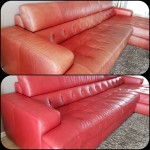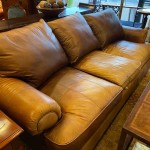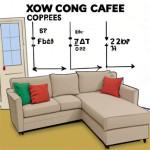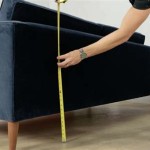```html
The Enduring Appeal of the 1970s Leather Sofa
The 1970s marked a distinct shift in interior design, moving away from the rigid formality of previous decades towards a more relaxed and expressive aesthetic. This change was reflected significantly in furniture choices, and the leather sofa emerged as a key piece, embodying both comfort and a certain rebellious sophistication. Understanding the appeal and characteristics of the 1970s leather sofa requires examining the materials used, the common design features, and the social context that contributed to its popularity.
Leather, as a material, has a long and storied history in furniture making. Its durability, natural variations in texture and color, and the way it ages over time contribute to its enduring appeal. However, in the 1970s, leather enjoyed a particular resurgence, partly due to its association with the burgeoning counter-culture and the shift towards more natural and earthy materials in home decor. The 1970s leather sofa wasn't just about practicality; it was about making a statement.
Key Point 1: Materials and Construction
The quality of a 1970s leather sofa hinges significantly on the type of leather used. Top-grain leather, derived from the outermost layer of the hide, was prized for its smooth finish and relatively uniform appearance. However, full-grain leather, which includes all layers of the hide, was also utilized, offering a more rugged and natural look, showcasing imperfections like scars and wrinkles. These variations in texture were often considered desirable, adding to the sofa's unique character.
The tanning process is crucial to the final appearance and durability of the leather. Vegetable tanning, using natural tannins from plants, was a traditional method that produced a supple leather with a warm, earthy tone. Chrome tanning, a more modern and faster process, was also common, resulting in a leather that was more resistant to water damage and fading. The choice of tanning method influenced not only the leather's look and feel but also its longevity.
Beyond the leather itself, the internal construction of the sofa was equally important. Solid wood frames, often made from hardwoods like oak or maple, provided a sturdy foundation. Spring systems, either coil springs or sinuous springs, offered support and resilience in the seating. Padding materials varied, ranging from foam to down, with the combination of these materials affecting the overall comfort and firmness of the sofa.
The stitching and detailing also contribute to the overall quality and aesthetic. Reinforced stitching along seams ensured durability, while decorative elements, such as tufting or piping, added visual interest. The attention to detail in the construction of a 1970s leather sofa reflected a commitment to craftsmanship and longevity, distinguishing it from mass-produced furniture of later decades.
Key Point 2: Design Features and Common Styles
Several distinct design features characterize the 1970s leather sofa. Low-slung profiles were common, emphasizing relaxation and informality. Deep seating areas, often paired with generously padded cushions, invited lounging and comfort. The overall silhouette tended to be more organic and less rigidly structured than sofas from previous decades, reflecting a move away from formal parlor settings towards more casual living spaces.
Color palettes for 1970s leather sofas typically leaned towards earthy tones. Shades of brown, ranging from rich chocolate to lighter tans and ochres, were particularly popular. Avocado green, burnt orange, and mustard yellow were also frequently used, reflecting the broader color trends of the era. These warm and inviting colors contributed to the sofa's overall sense of comfort and style.
Modular sofa designs gained popularity during this period, allowing for flexible configurations and adaptability to different spaces. These modular units could be arranged in various ways, creating L-shaped sofas, sectionals, or even individual seating pieces. This versatility made them ideal for both small apartments and larger homes, catering to a variety of lifestyles.
Specific styles of 1970s leather sofas also emerged as distinct trends. The "conversation pit" style, featuring a sunken seating area surrounded by cushions, was a bold statement of informality and social interaction. The "sling" style, with leather suspended between a frame, offered a more minimalist and modern aesthetic. These different styles reflected the diverse design influences of the era, from the earthy tones of the counter-culture to the sleek lines of modernism.
Key Point 3: Social and Cultural Context
The rise of the 1970s leather sofa cannot be fully understood without considering the social and cultural context of the time. The decade was marked by significant social change, including a rejection of traditional norms and a growing emphasis on individual expression. This shift influenced interior design, with people seeking furniture that reflected their personal style and values.
The counter-culture movement, with its focus on natural materials and handcrafted goods, contributed to the popularity of leather furniture. Leather was seen as a more authentic and honest material than synthetic alternatives, aligning with the values of the time. The association of leather with ruggedness and individuality also resonated with a generation seeking to break free from conformity.
The increasing affluence of the middle class allowed more people to invest in higher-quality furniture. Leather sofas, while more expensive than fabric-covered options, were seen as a worthwhile investment due to their durability and longevity. The perception of leather as a symbol of status and sophistication also contributed to its desirability.
The influence of popular culture, including films, television shows, and magazines, also played a role in shaping furniture trends. The presence of leather sofas in popular media helped to normalize and popularize the material, making it a desirable addition to homes across the country. The 1970s leather sofa became more than just a piece of furniture; it was a symbol of a particular era and a reflection of the changing social landscape.
The prevalence of open-plan living spaces in newly constructed homes further fueled the demand for larger and more comfortable seating arrangements. The 1970s leather sofa, with its deep seating and modular designs, was well-suited to these open spaces, providing a focal point for relaxation and social interaction.
Ultimately, the enduring appeal of the 1970s leather sofa lies in its combination of quality materials, distinctive design features, and its embodiment of the social and cultural values of the era. It remains a sought-after piece of furniture for those seeking comfort, style, and a touch of vintage charm.
```
Mid Century Italian Space Age Leather 3 Seater Sofa 1970s For At Pamono

Vintage Leather Modular Sofa Set By Michel Ducaroy For Ligne Roset 1970s Of 3 At Pamono

Distressed Leather Beauty Hudson Sofa Set In Retro Style

Antiques Atlas A 1970s Leather Sofa By Pieff

Barrington Vintage Leather Sofa Chesterfield Sofas
.jpg?strip=all)
Luxury Vintage Sofa Suite Handcrafted By Wellington Chesterfield

Mid Century Italian Space Age Leather 3 Seater Sofa 1970s For At Pamono
.jpg?strip=all)
The Epitome Of Elegance Vintage Distressed Leather Suite

Hepburn Vintage Leather 3 Seater Sofa From Old Boot Sofas

Mid Century Italian Space Age Leather 3 Seater Sofa 1970s For At Pamono








